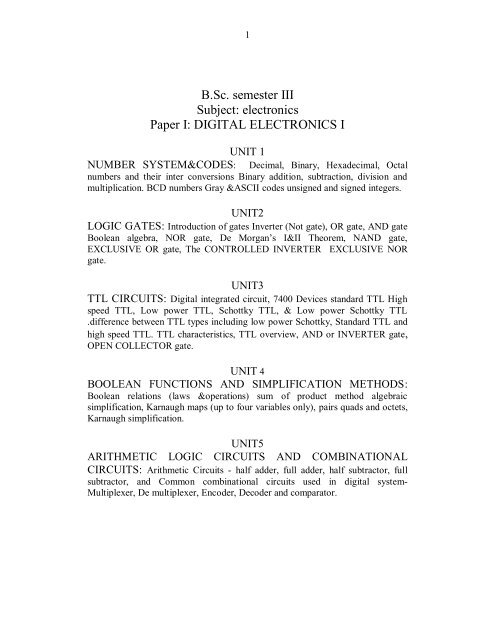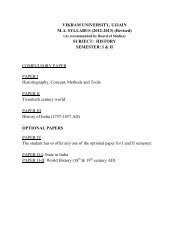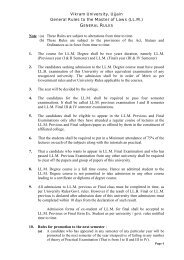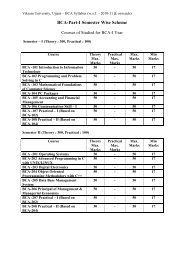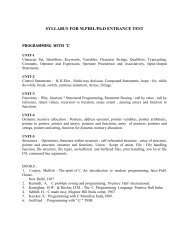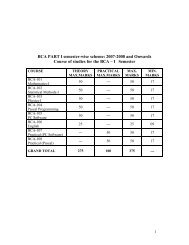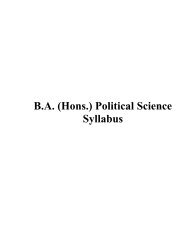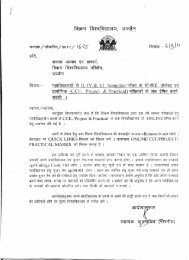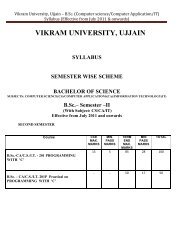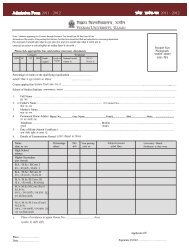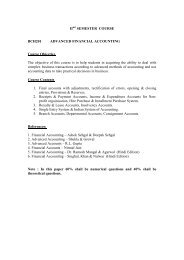B.Sc. semester III Subject: electronics Paper I: DIGITAL ...
B.Sc. semester III Subject: electronics Paper I: DIGITAL ...
B.Sc. semester III Subject: electronics Paper I: DIGITAL ...
Create successful ePaper yourself
Turn your PDF publications into a flip-book with our unique Google optimized e-Paper software.
1B.<strong>Sc</strong>. <strong>semester</strong> <strong>III</strong><strong>Subject</strong>: <strong>electronics</strong><strong>Paper</strong> I: <strong>DIGITAL</strong> ELECTRONICS IUNIT 1NUMBER SYSTEM&CODES: Decimal, Binary, Hexadecimal, Octalnumbers and their inter conversions Binary addition, subtraction, division andmultiplication. BCD numbers Gray &ASCII codes unsigned and signed integers.UNIT2LOGIC GATES: Introduction of gates Inverter (Not gate), OR gate, AND gateBoolean algebra, NOR gate, De Morgan’s I&II Theorem, NAND gate,EXCLUSIVE OR gate, The CONTROLLED INVERTER EXCLUSIVE NORgate.UNIT3TTL CIRCUITS: Digital integrated circuit, 7400 Devices standard TTL Highspeed TTL, Low power TTL, <strong>Sc</strong>hottky TTL, & Low power <strong>Sc</strong>hottky TTL.difference between TTL types including low power <strong>Sc</strong>hottky, Standard TTL andhigh speed TTL. TTL characteristics, TTL overview, AND or INVERTER gate,OPEN COLLECTOR gate.UNIT 4BOOLEAN FUNCTIONS AND SIMPLIFICATION METHODS:Boolean relations (laws &operations) sum of product method algebraicsimplification, Karnaugh maps (up to four variables only), pairs quads and octets,Karnaugh simplification.UNIT5ARITHMETIC LOGIC CIRCUITS AND COMBINATIONALCIRCUITS: Arithmetic Circuits - half adder, full adder, half subtractor, fullsubtractor, and Common combinational circuits used in digital system-Multiplexer, De multiplexer, Encoder, Decoder and comparator.
2B.<strong>Sc</strong>. <strong>semester</strong> <strong>III</strong><strong>Subject</strong>: <strong>electronics</strong><strong>Paper</strong> II: APPLIED ELECTRONICS IUNIT1FEED BACK: general theory of feedback, classification of feedback, closedloop gain, open loop gain & their return differences, advantage of negative feedback, gain stability decreased distortion, increased band width, forms of negativefeed back: voltage series feedback, voltage shunt feedback, current shuntfeedback, current shunt feedback.(Numerical exercises related to feedback).UNIT2MULTISTAGE AMPLIFIRES: general – amplifier-coupling RC coupledtwo-stage amplifier, advantages of RC coupling Impedance coupled two-stageamplifier, advantages of Impedance coupling Transformer coupled two-stageamplifier, advantages of Transformer coupling Direct coupled two stageamplifier, advantages of Direct coupling and conventional problem related tothem.UNIT3FIELD EFFECT TRANSISTOR AMPLIFIRE: Introduction, biasing ofFET, JFET ,gate bias, Q point, voltage divider bias, source bias, current sourcebias, biasing of enhancement MOSFET and depletion MOSFET, FET amplifier,Common source amplifier, Common drain amplifier, Common gate amplifier(Numerical exercises related to different FET amplifier).UNIT4SINUSODIAL OSILLATORS: Introduction comparison between amplifierand oscillator, classification, applications, nature, circuit, frequency, frequencystability of an oscillator, Barkhausen criterion, tuned circuit oscillator, Hartleyoscillator, Colpitts oscillator, Clapp oscillator, Crystal oscillator, RC oscillator,Phase shift oscillator, Wein bridge oscillator, (qualitative study).UNIT5NON-SINUSODIAL OSILLATORS: Introduction, classification, transistoras a switch, Multivibrator: types of Multivibrator, A stable Multivibrator, Monostable Multivibrator Bi stable Multivibrator applications of Multivibrator blockingoscillator (qualitative study).
3B.<strong>Sc</strong>. <strong>semester</strong> IV<strong>Subject</strong>: <strong>electronics</strong><strong>Paper</strong> I: <strong>DIGITAL</strong> ELECTRONICS IIUNIT 1FLIP – FLOPS: RS flip-flop (different latches), D latches, Edge Triggered Dflip- flop, JK flip – flop, JK master slave flip flop, concept of racing and levelclocking.UNIT2REGISTERS & COUNTERS: Buffer register, Shift register, Controlled shiftregisters, Ripple counters, synchronous counters, ring counters, Decade counters,and Pre settable counters.UNIT 3MEMORY: Basic terms and ideas, Magnetic memory Optical memory,Memory addressing, ROMs, PROMs, EPROMs, and RAMs.UNIT 4<strong>DIGITAL</strong> - TO - ANALOG CONVERTERS: digital and analogrepresentation D/A conversion, weighted-resistor digital to analog converter,ladder – type D/A converter, binary ladders,4-bit D/A Converter, multiple signals,performance characteristics of D/A converter applications of D/A converter.UNIT5ANALOG –TO- <strong>DIGITAL</strong> CONVERTERS: analog to digital conversion,simultaneous A/D converter, stair step – ramp A/D converter, single slope A/Dconverter, dual slope A/D converter, successive approximation A/D converter,parallel conversion parallel/ serial conversion performance characteristics of A/Dconverter applications of A/D converter.
4B.<strong>Sc</strong>. <strong>semester</strong> IV<strong>Subject</strong>: <strong>electronics</strong><strong>Paper</strong> II: APPLIED ELECTRONICS IIUNIT1WAVE SHAPING I: Introduction, different, non-sinusoidal wave shapes,types of wave shaping circuits, linear wave shaping circuits, differentiatingcircuit, applications. generation of narrow pulse from square wave, generation ofvoltage step from a ramp, generation of square wave from triangular wave,integrating circuits applications, generation of triangular wave from square wave,generation of saw tooth wave from triangular wave.(Qualitative study andnumerical).UNIT2WAVE SHAPING II: nonlinear wave shaping circuits, Clipping circuit:positive clippers, negative clippers, biased clippers, combination clippers, twolevel slicer, clamping circuits, biased clampers practical clamper circuitapplications voltage multipliers voltage Doublers, voltage trippler andquadrupler.(Qualitative study and numerical).UNIT3INTEGRATED CIRCUITS AND OPERATIONAL AMPLIFIRES:introduction, classification of IC scale of integration, fabrication of ICcomponents fabrication of monolithic IC operational amplifiers: introductions opampsupply voltage, op-amp parameters, op-amp offset voltage and current,concept of virtual ground characteristics of ideal op-amp architecture of a typicalIC op-amp. .(Qualitative study and numerical).UNIT4APPLICATIONS OF OP-AMP I: op-amp as a voltage amplifier, invertingamplifier, scale changer, phase shifter, non inverting amplifier, unity gainfollower, the voltage follower, adder or summing amplifier, differential amplifierop-amp frequency response, frequency versus gain characteristics of an op-amp. .(Qualitative study and numerical)UNIT5APPLICATIONS OF OP AMP II: Sub tractor, integrator, differentiator,voltage to current converter, current to voltage converter, voltage comparator,square wave generator, regenerative comparator triangular wave generator,logarithmic amplifier active half wave rectifier active peak detector analogcomputation .(Qualitative study and numerical).


